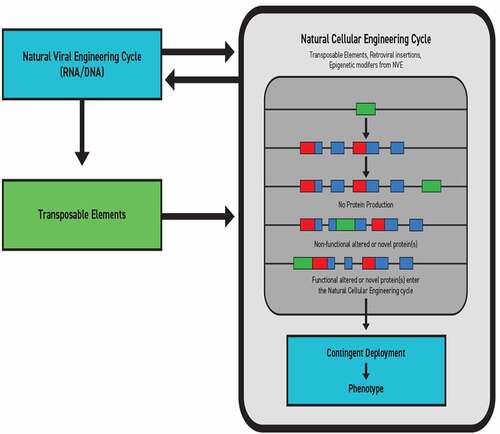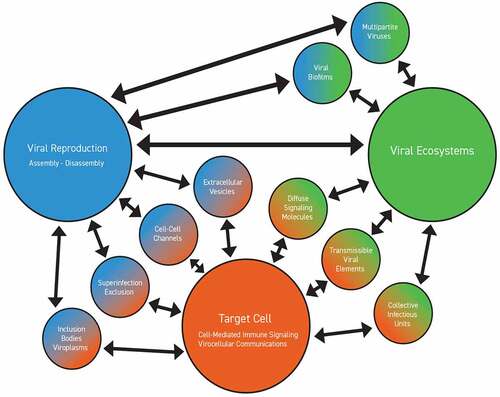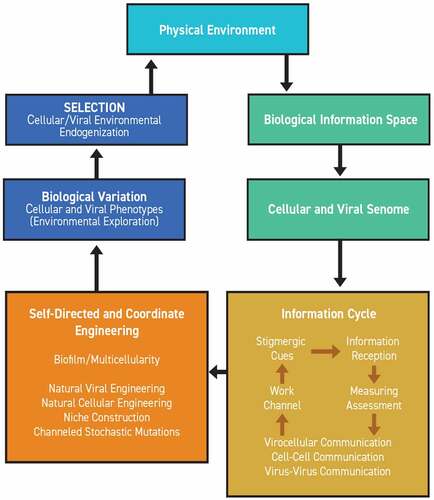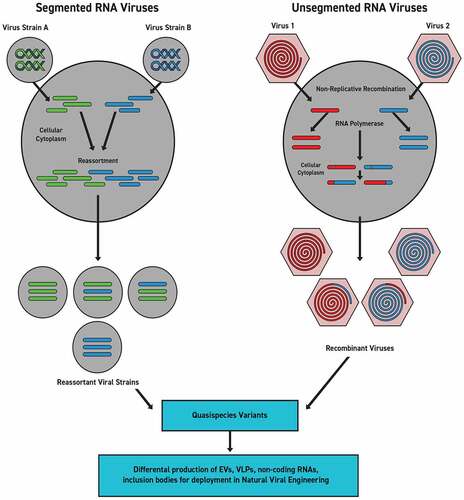Figures & data
Figure 1. Viral-cellular engineering cycle.Co-engineering in Cognition-Based Evolution is based on a co-respondent relationship between NVE and elements of genetic exchange, such as transposable elements, that reciprocate with a Natural Cellular Engineering cycle. Sequence insertions or deletions yield variable proteomic outputs, either unchanged protein production, a new nonfunctional protein, or a functional or novel protein capable cells can deploy as phenotypic variation.

Figure 2. Sociovirology, viral ecosystems, and virocellular communications.Viruses exhibit extensive social attributes, enabling coordinate virus-virus and virocellular communications through multiple signaling pathways. Collectively, these enable the lytic-lysogenic decision matrices of viruses, enacted through the social principles of collective action, co-dependence, and competition that underpin viral ecosystems.

Figure 3. Information management within Cognition-Based Evolution.Biological information space is constituted by environmental cues which impact the senomes of self-referential cells and viruses. Information reception initiates a reiterative information cycle that permits viral and cellular natural co-engineering. Information is received, measured, communicated, and deployed, energizing an obligatory work channel reinforced by stigmergic cues. That information cycle is the backbone of Natural Cellular Engineering, Natural Viral Engineering, and niche constructions. Natural genomic editing and stochastic events are channeled aspects of the engineering cycle. These act coordinately to produce biological variations as phenotypic alterations for environmental exploration. Those variations are subject to filtering selection directed toward the continuous virocellular endogenization of the external environment.

Figure 4. DNA viral exchanges for Natural Viral Engineering.Viruses can exchange modular genetic segments, which can participate in natural genetic editing as ‘plug-in cassettes’. These modular genetic segments can represent substrates for various retroelements that participate in natural viral-cellular engineering, enabling exon shuffling or altering cis-regulatory sites. These exchanges contribute to the pool of mobile DNA as part of the fluid trans-kingdom transfer of genetic material.

Figure 5. RNA viral reassortment-recombination in Natural Viral Engineering.Segmented and unsegmented RNA viruses undergo reassortment or recombination within cells, producing reassortment-recombinant viral strains as new variants. These vary further as quasi-species, providing a flexible means of evaluating the cellular environment. All can participate in the differential production of substrates for NVE as VLPs, non-coding RNAs, inclusion bodies, or as participants within EVs.

